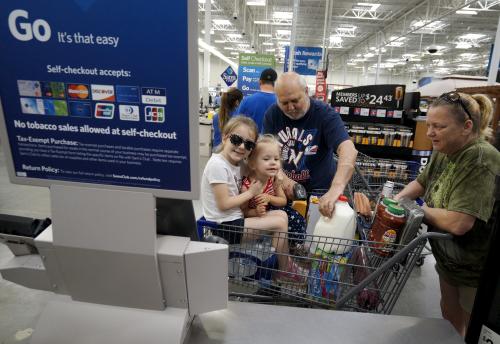An important milestone has just been passed: more women than men are now better educated than their spouse. A chart produced by Wendy Wang over at the Institute of Family Studies shows that in one in four marriages, wives boast higher educational credentials than their husbands:
This is not surprising, given the way that women have caught up with, and now overtaken, men in terms of education. (It is important to note that these trends differ quite sharply by race, however, with black husbands much more likely to have lower education levels. We’ll be blogging separately on that point next week.)
Wives: learning more, still earning less
Despite the fact that women are now better educated than men, Wang goes on to show that wives nonetheless continue to lag behind their husbands in terms of wages, for a number of reasons, including occupational differences and the division of caring work. As Wang puts it: “Even when women ‘marry down’ educationally, they continue to ‘marry up’ in income.”
At the same time, the economic value of a college education has risen. Women across the educational spectrum have seen their wages rise in recent decades, but the sharpest increases have been for those with four-year college degrees. Meanwhile, the only group of men who have seen a wage rise since 1980 are those with a BA:
The marriage gap, fueling an income gap
So both men and women with four-year degrees have seen a jump in their individual earnings. These gains very often accrue to the same households. Well-educated people tend to marry each other, a process with the unromantic label of “assortative mating.” One in ten marriages (9 percent) are now between two college graduates. Another 6 percent are between a couple where both have a post-graduate degree. Not only are they more likely to be married to each other, college-educated Americans are more likely to be married at all. Three in four (74%) of adults aged 35 to 45 with a four-year college degree are married with a spouse present in the same household, compared to 54 percent of those with a high school diploma:
BA Marries BA, inequality rises
So, women’s earnings are now a closer to men’s—and especially to the men they are married to. This has further fueled family income inequality. Our colleague Gary Burtless finds that 13 percent of the rise in adjusted personal income inequality between 1979 and 1996 occurred because of an increase in the correlation of spouses’ earned incomes. Similarly, Christine Schwartz estimates that if the correlation between spouses’ earnings had not increased, the rise in inequality of earned income among married couples from 1967 to 2005 would have been about 25 to 30 percent less.
The combined effect of these four factors combined—increased educational attainment among women, rising labor market returns to education, the marriage gap by education level, and assortative mating—has been to push up income inequality at the family level.
Income inequality is then being driven, at least in part, by forces that most commentators would welcome, including dramatic improvements in women’s education (though concurrent declines in men’s education are less welcome), or which lie well beyond the reach of public policy, such as our apparent preference for a similarly-educated husband or wife. Inequality results from a complex mix of social and economic factors; a fact that policy makers would be wise to remember.
The Brookings Institution is committed to quality, independence, and impact.
We are supported by a diverse array of funders. In line with our values and policies, each Brookings publication represents the sole views of its author(s).












Commentary
College friends keep getting married? It’s bad news for your travel budget… and inequality
November 17, 2017